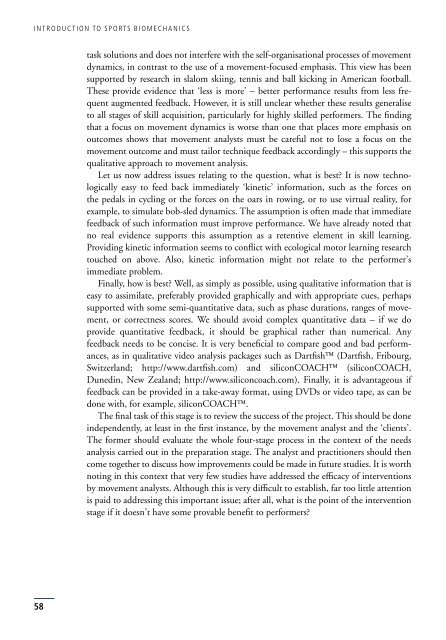Introduction to Sports Biomechanics: Analysing Human Movement ...
Introduction to Sports Biomechanics: Analysing Human Movement ...
Introduction to Sports Biomechanics: Analysing Human Movement ...
Create successful ePaper yourself
Turn your PDF publications into a flip-book with our unique Google optimized e-Paper software.
INTRODUCTION TO SPORTS BIOMECHANICS<br />
58<br />
task solutions and does not interfere with the self-organisational processes of movement<br />
dynamics, in contrast <strong>to</strong> the use of a movement-focused emphasis. This view has been<br />
supported by research in slalom skiing, tennis and ball kicking in American football.<br />
These provide evidence that ‘less is more’ – better performance results from less frequent<br />
augmented feedback. However, it is still unclear whether these results generalise<br />
<strong>to</strong> all stages of skill acquisition, particularly for highly skilled performers. The finding<br />
that a focus on movement dynamics is worse than one that places more emphasis on<br />
outcomes shows that movement analysts must be careful not <strong>to</strong> lose a focus on the<br />
movement outcome and must tailor technique feedback accordingly – this supports the<br />
qualitative approach <strong>to</strong> movement analysis.<br />
Let us now address issues relating <strong>to</strong> the question, what is best? It is now technologically<br />
easy <strong>to</strong> feed back immediately ‘kinetic’ information, such as the forces on<br />
the pedals in cycling or the forces on the oars in rowing, or <strong>to</strong> use virtual reality, for<br />
example, <strong>to</strong> simulate bob-sled dynamics. The assumption is often made that immediate<br />
feedback of such information must improve performance. We have already noted that<br />
no real evidence supports this assumption as a retentive element in skill learning.<br />
Providing kinetic information seems <strong>to</strong> conflict with ecological mo<strong>to</strong>r learning research<br />
<strong>to</strong>uched on above. Also, kinetic information might not relate <strong>to</strong> the performer’s<br />
immediate problem.<br />
Finally, how is best? Well, as simply as possible, using qualitative information that is<br />
easy <strong>to</strong> assimilate, preferably provided graphically and with appropriate cues, perhaps<br />
supported with some semi-quantitative data, such as phase durations, ranges of movement,<br />
or correctness scores. We should avoid complex quantitative data – if we do<br />
provide quantitative feedback, it should be graphical rather than numerical. Any<br />
feedback needs <strong>to</strong> be concise. It is very beneficial <strong>to</strong> compare good and bad performances,<br />
as in qualitative video analysis packages such as Dartfish (Dartfish, Fribourg,<br />
Switzerland; http://www.dartfish.com) and siliconCOACH (siliconCOACH,<br />
Dunedin, New Zealand; http://www.siliconcoach.com). Finally, it is advantageous if<br />
feedback can be provided in a take-away format, using DVDs or video tape, as can be<br />
done with, for example, siliconCOACH.<br />
The final task of this stage is <strong>to</strong> review the success of the project. This should be done<br />
independently, at least in the first instance, by the movement analyst and the ‘clients’.<br />
The former should evaluate the whole four-stage process in the context of the needs<br />
analysis carried out in the preparation stage. The analyst and practitioners should then<br />
come <strong>to</strong>gether <strong>to</strong> discuss how improvements could be made in future studies. It is worth<br />
noting in this context that very few studies have addressed the efficacy of interventions<br />
by movement analysts. Although this is very difficult <strong>to</strong> establish, far <strong>to</strong>o little attention<br />
is paid <strong>to</strong> addressing this important issue; after all, what is the point of the intervention<br />
stage if it doesn’t have some provable benefit <strong>to</strong> performers?






